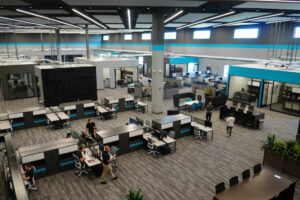The World and Workforce is Changing. Build a Modern Workplace.
Part 1: Change Your Mindset
 The days of corner offices, mahogany desks, and traditionally structured work days are fading into the past. Today’s employees place value on more than just compensation – they want flexible schedules, benefits and a healthy workplace culture. As a result, companies need to rethink their approach to the workplace.
The days of corner offices, mahogany desks, and traditionally structured work days are fading into the past. Today’s employees place value on more than just compensation – they want flexible schedules, benefits and a healthy workplace culture. As a result, companies need to rethink their approach to the workplace.
Studies show that people desire jobs that allow them to control their work schedules and the amount of time spent in the office. According to State of Work in America, a study performed by Grant Thornton LLP, 79% of survey respondents are looking for flexibility in both when and where they work and 40% say they will look for another job if their current employer forces them to spend every workday in the office.
The way companies manage employees is changing and the workplace has to evolve accordingly. Providing flexibility does not mean allowing employees to work from home full-time nor does it mean requiring them to be in the office five days a week. In today’s modern approach to the workplace, companies need to create an engaging experience that focuses on the aspects of the workplace employees most value.
Attract and Retain Talent
The study also found that 33% of those surveyed are actively looking for a new job with a different company and 45% do not believe that their employer understands their needs as an employee. What can business owners do to not only retain the talent they have, but attract the millions of people looking for new, better employment opportunities? Nathan Maurer, President and CEO of COCRE8 Interiors, says that a well-designed workplace impacts both talent retention and recruitment.
“Every workplace is going to be different, depending on an organization’s culture and function. Employees feel at home in a well-designed workplace. They are comfortable and their needs are met. If your company is not providing an ideal workspace, employees will find a place that does,” says Maurer.

How that space is configured is dependent on the type of business and how the space is utilized. A CPA firm and a marketing firm will have spaces as different as their employee’s job descriptions yet both can be considered ideal workplaces. Companies need to consider how employees use the space – some will require more collaborative spaces while others need private, individual workspaces.
Meeting Employee Needs
Maurer says workplaces should provide three key needs: a home, a toolkit and a cultural hub.
- Home: The workplace is more than just an office, it serves as your company’s home. Employees should feel comfortable and engaged in the space. Employees should want to spend time in the office collaborating with coworkers and working effectively.
- Toolkit: The workplace serves as a toolkit of the things your employees need to be productive, whether that is individual offices, conference rooms, or break rooms. The function of the space itself is the toolkit. Productive workspaces have the right tools in place for employees to be successful. Just like a carpenter needs a hammer, you have to give your employees the tools they need to achieve.
- Cultural Hub: In order for people to buy into the culture, the space needs to reflect the company’s overall vision. A cultural hub has the same look, feel, and flow throughout the space while allowing individualism in an employee’s personal workplace. Everything from colors to fixtures should be selected with the company’s culture in mind.
The first step to designing the optimal workplace for your company is to determine what employees value and what they expect from their employer. Are their needs being met currently? Where can you improve as an organization to create a more desirable workplace? Use this opportunity to identify what causes your employees stress and fine ways to relieve those issues.
company is to determine what employees value and what they expect from their employer. Are their needs being met currently? Where can you improve as an organization to create a more desirable workplace? Use this opportunity to identify what causes your employees stress and fine ways to relieve those issues.
Giving your employees a voice in the form and function of the workplace results in a more engaged, connected workforce.
Part Two: Form and Function discusses the steps companies should take to create their vision for a well-designed workplace and make it a reality. Check it out Here.
